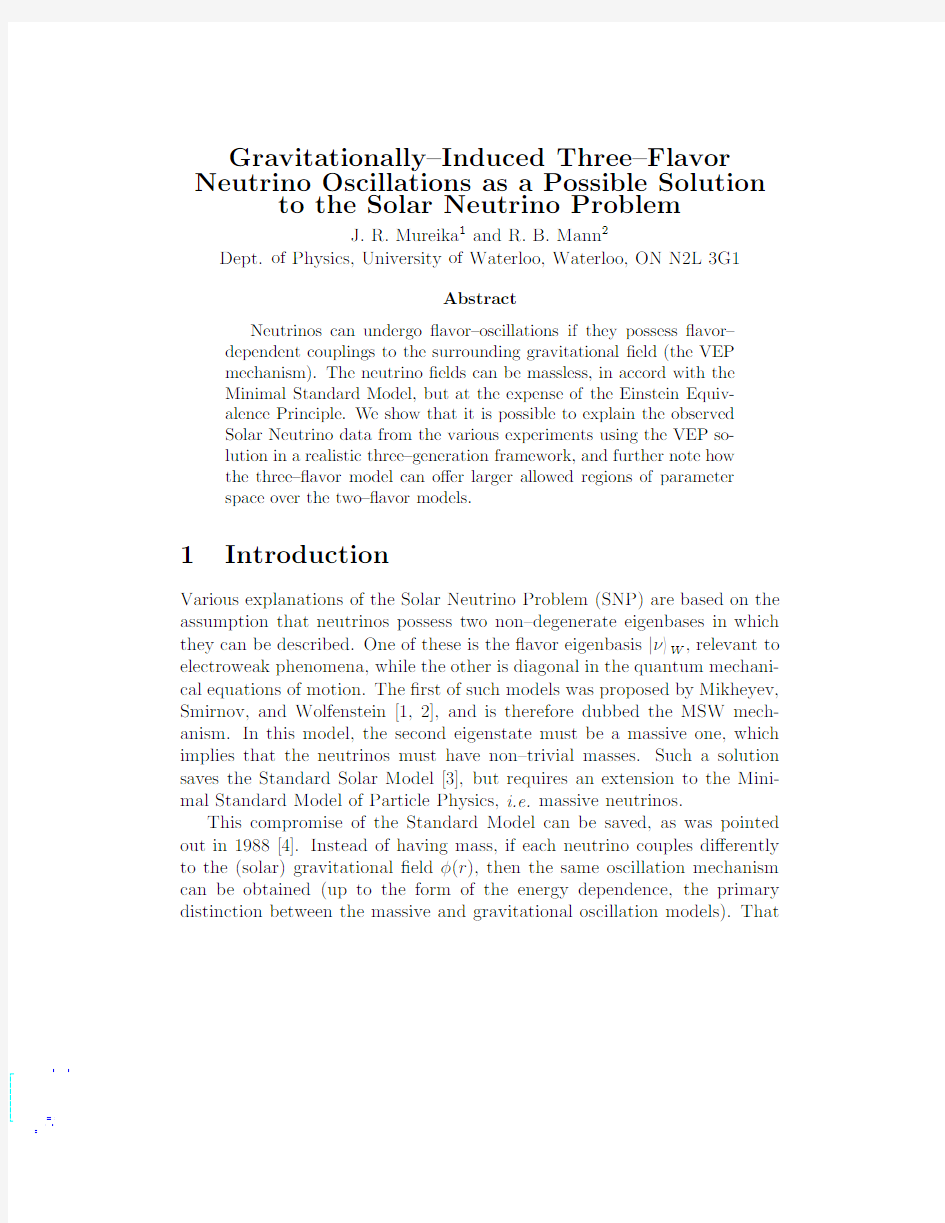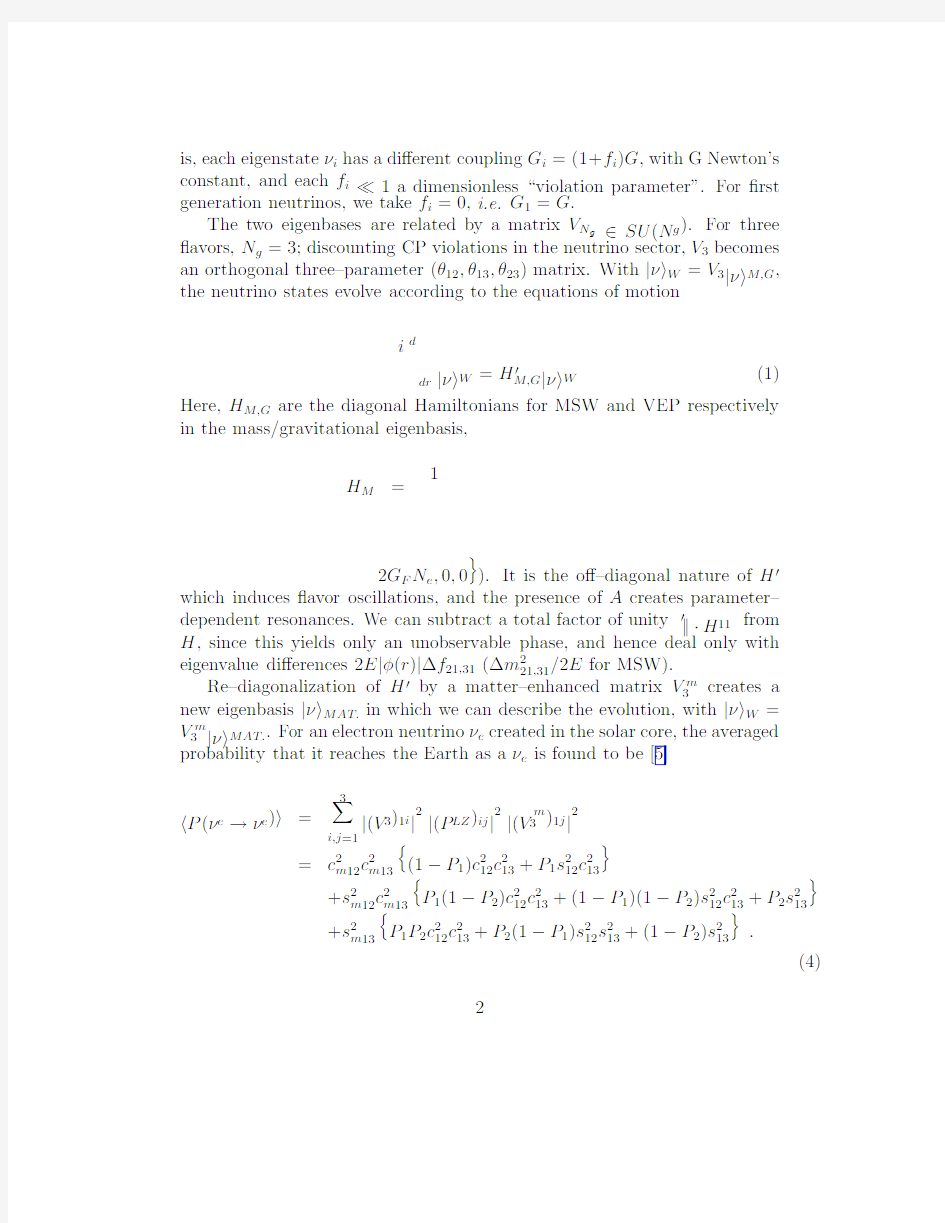Gravitationally--Induced Three--Flavor Neutrino Oscillations as a Possible Solution to the


a r X i v :h e p -p h /9507355v 1 20 J u l 1995
Gravitationally–Induced Three–Flavor Neutrino Oscillations as a Possible Solution
to the Solar Neutrino Problem
J.R.Mureika 1and R.B.Mann 2
Dept.of Physics,University of Waterloo,Waterloo,ON N2L 3G1
Abstract
Neutrinos can undergo ?avor–oscillations if they possess ?avor–dependent couplings to the surrounding gravitational ?eld (the VEP mechanism).The neutrino ?elds can be massless,in accord with the Minimal Standard Model,but at the expense of the Einstein Equiv-alence Principle.We show that it is possible to explain the observed Solar Neutrino data from the various experiments using the VEP so-lution in a realistic three–generation framework,and further note how the three–?avor model can o?er larger allowed regions of parameter space over the two–?avor models.
1Introduction
Various explanations of the Solar Neutrino Problem (SNP)are based on the assumption that neutrinos possess two non–degenerate eigenbases in which they can be described.One of these is the ?avor eigenbasis |ν W ,relevant to electroweak phenomena,while the other is diagonal in the quantum mechani-cal equations of motion.The ?rst of such models was proposed by Mikheyev,Smirnov,and Wolfenstein [1,2],and is therefore dubbed the MSW mech-anism.In this model,the second eigenstate must be a massive one,which implies that the neutrinos must have non–trivial masses.Such a solution saves the Standard Solar Model [3],but requires an extension to the Mini-mal Standard Model of Particle Physics,i.e.massive neutrinos.
This compromise of the Standard Model can be saved,as was pointed out in 1988[4].Instead of having mass,if each neutrino couples di?erently to the (solar)gravitational ?eld φ(r ),then the same oscillation mechanism can be obtained (up to the form of the energy dependence,the primary distinction between the massive and gravitational oscillation models).That
is,each eigenstateνi has a di?erent coupling G i=(1+f i)G,with G Newton’s constant,and each f i?1a dimensionless“violation parameter”.For?rst generation neutrinos,we take f i=0,i.e.G1=G.
The two eigenbases are related by a matrix V N
g∈SU(N g).For three
?avors,N g=3;discounting CP violations in the neutrino sector,V3becomes an orthogonal three–parameter(θ12,θ13,θ23)matrix.With|ν W=V3|ν M,G,
the neutrino states evolve according to the equations of motion
i d
dr|ν W=H′M,G|ν W(1) Here,H M,G are the diagonal Hamiltonians for MSW and VEP respectively
in the mass/gravitational eigenbasis,
1
H M=
2G F N e,0,0 ).It is the o?–diagonal nature of H′which induces?avor oscillations,and the presence of A creates parameter–dependent resonances.We can subtract a total factor of unity′||·H11from
H,since this yields only an unobservable phase,and hence deal only with eigenvalue di?erences2E|φ(r)|?f21,31(?m221,31/2E for MSW).
Re–diagonalization of H′by a matter–enhanced matrix V m3creates a new eigenbasis|ν MAT.in which we can describe the evolution,with|ν W=
V m3|ν MAT..For an electron neutrinoνe created in the solar core,the averaged probability that it reaches the Earth as aνe is found to be[5]
P(νe→νe) =3 i,j=1|(V3)1i|2|(P LZ)ij|2|(V m3)1j|2
=c2m12c2m13 (1?P1)c212c213+P1s212c213
+s2m12c2m13 P1(1?P2)c212c213+(1?P1)(1?P2)s212c213+P2s213
+s2m13 P1P2c212c213+P2(1?P1)s212s213+(1?P2)s213 .
(4)
2
Here,s ij,c ij≡sinθij,cosθij and s mij,c mij≡sinθm ij,cosθm ij are the parame-ters of V3and V m3,respectively.The matrix P LZ has elements P1,2which de-scribe the probability of non–adiabatic level crossing betweenνe→νμ,νe→ντ(hereafter12–and13–transitions).
2Behavior of P(νe→νe) for a Double Res-onance
If theνe s are created at electron densities higher than the corresponding res-onance density for either12–or13–transitions,then the matter–enhanced mixing angles approach the valueθm12,θm13→π
3Comparison of8B Neutrino Fluxes
As previously mentioned,the di?erence between the two oscillation mech-anisms resides in their energy dependence.A study of the spectrum of8B neutrinos incident on terrestrial detectors can help shed light on which sup-pression mechanism,if any,is at work.In the previous section,the largeθ13 form was shown to be energy independent,while the smallθ13case is a func-tion of both12–and13–transitions.So,we should expect to see some type of spectral distortion in the8B neutrino?ux in this small angle case[6,8].Fig-ure2shows that the attenuation ofνe s is indeed a?ected quite di?erently by each model:MSW suppresses low–energy neutrinos,while VEP suppresses higher–energy ones.Since detectors such as Kamiokande II,or SNO(when it comes online)can detect subtle variations in the high energy portion of the?ux spectrum,we would expect such behavior as that in?gure2to be a major clue as to the solution of the SNP.
Acknowledgements
This work was supported in part by the Natural Sciences and Engineering Research Council of Canada.
References
[1]S.P.Mikheyev and A.Yu.Smirnov,Yad.Fiz.42,1441(1985).
[2]L.Wolfenstein,Phys.Rev.D17,2369(1978).
[3]J.N.Bahcall and M.H.Pinsonneault,Rev.Mod.Phys.64,885(1992).
[4]M.Gasperini,Phys.Rev.D38,2635(1988).
[5]A.Baldini and G.F.Giudice,Phys.Lett.B186,211(1987).
[6]J.Mureika,M.Sc.Thesis(1995).
[7]J.Pantaleone,A.Halprin,and C.N.Leung,Phys.Rev.D47(1993)
R4199;M.N.Butler et al.,Phys.Rev.D47,2615(1993);J.N.Bahcall, P.I.Krastev,and C.N.Leung,gr-qc/9410353.
[8]J.Mureika and R.B.Mann,work in progress.
4
Figure1:3σoverlap for data from[3],with?f31=10?13,s213=0.4
Figure2:MSW and VEP reduced?uxes yielding counting rate R= 2.00SNU,with both12–and13–resonances allowed.
5
